Wintergen
Script error: The module returned a nil value. It is supposed to return an export table.
Wintergen
Ouintergene | |
|---|---|
Province of Burgundie | |
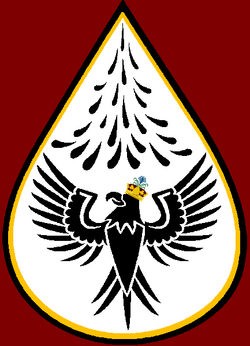 COA of Wintergen | |
| Nickname: Evergreen Republic | |
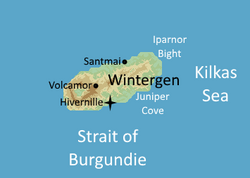 Map of Wintergen | |
| Nation | |
| Constituent Country | Burgoignesc Overseas Territory Assembly |
| Geographic designation | Polar Burgundies |
| Capital City | Hivernille |
| Area | |
| • Total | 5,775.673 km2 (2,230.000 sq mi) |
| Population | |
| • Total | 719,990 |
| • Density | 120/km2 (320/sq mi) |
| Demonym | Ouintergens |
| Website | www.burgundie.gouv/wintergen |
Wintergen (Burg: Ouintergene), is an over-seas province of Burgundie located in the eastern Kilikas Sea. It shares a maritime border with Faneria to the southwest and Vithinja to the northeast. It is part of Burgundie's Burgoignesc Overseas Territory Assembly's Polar Burgundies geographic designation. It is home to 719,990 Ouintergens. It's capital and largest city is Hivernille which also serves as the province's largest port facility. Most of the island's residents live in one of three large settlements, Hivernille, Volcamor, or Santmai. The reminder of the island is kept uninhabited by the logging companies who own the vast majority of the land.
Wintergen is known for its jagged, rocky Kilikas Sea coastlines; the extinct volcano in the western third of the island; the heavily forested interior; picturesque waterways; and its wild lowbush blueberries and seafood cuisine, especially lobster and clams. Santmai has emerged as a Creative economy hub for Burgoignesc, Vithinjan, and Fanerian yuppies. As a result, Santmai is experiencing a high degree of gentrification while Hivernille and Volcamor are considered grubby working-class towns.
Geography
-
Rocky shores that endemic to most of Wintergen's coast.
Climate
Wintergen has a subarctic, Hemiboreal climate attributable to its proximity to the waters of the Kilikas Sea.
| Location | July (°C) | July (°F) | January (°C) | January (°F) |
|---|---|---|---|---|
| Hivernille | 20/11 | 68/52 | −1/−9 | 30/16 |
Natural Hazards
History
Wintergen is not known to have had a permanent population prior to the year 1000 anno Domini, though the Finnic peoples of Koskenkorva were aware of its existence and visited it sporadically for fishing purposes. It became known to Coscivian civilisation when it was sighted by Keður Valēkas' flagship during the return voyage of his first expedition to Great Kirav. A subsequent Coscivian expedition established a small settlement on the islands.
By the 19th century AD (XXXth century CC), most of Wintergen's small population lived in a handful of timber camps harvesting wood, most of which was exported to Burgundie to supply its prolific shipyards. Supplementary economic activities included fishing and subsistence farming, though the island suffered from poor soils and weather and a scarcity of arable land. Though some Coscivian families had lived on Wintergen for generations and spoke a unique (and now extinct) Coscivian dialect, most of the population were transient workers from Koskenkorva and the Far Northeast who lived on the island as fishermen and woodcutters for three or four seasons at most.
The 1820s a devastating bark beetle blight that almost eliminated the remaining forests on Burgundie. Desperate for more wood as the demand from timber-producing areas outstripped the local's ability to harvest it, some enterprising Port Diteauxoise shipwrights convinced the Burgoignesc North Levantine Trading Company (BNLTC) in 1823 to occupied the timber camps of Wintergen.
In 1836 the Golden Council of Ten decreed the Act of Economic Union, claiming that Wintergen was forevermore an integral part of Burgundie.
Following the island's capture and formalization into Burgundie, the Kiravian government and population were expelled. However, the conflicts with Burgundie bore on and [for some reason that I will maybe add here if applicable] were ultimately resolved in 1896 without settling the island's legal status.
Government
| This article is part of a series on the |
| BORA |
|---|
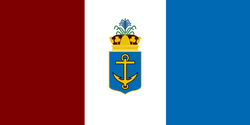 |
| Statistics |
|
| Key topics |
| Provinces |
|
Burgundie portal |
Wintergen is part of the Burgoignesc Overseas Territory Assembly's Polar Burgundies geographic designation. Burgoignesc Overseas Territory Assembly is a constituent country equivalent of Burgundie with its own assembly, prime minister, budget, and laws. Burgundie's national governmental influence is limited to subsidies, education, and security, however, its financial and cultural institutes cast a long shadow across Wintergen.
Wintergen is a province within Burgoignesc Overseas Territory Assembly with its own semi-elected Governor-Epistates, representative legislative body, and court system.
Ouintergens are Burgoigniacs/Burgoignix with complete civil and economic rights, and citizenship (political rights) under the same federal service criteria as all residents of Burgundie. Burgoignesc is the official language but Coscivian and Burgoignesc are both in use.
Provincial executive
The provincial executive is the Governor-Epistates. Three candidates are elected by a single transferable vote election held every 5 years, the three candidates are presented to the Court of St. Alphador and the next Governor-Epistates is chosen from these candidates. If the citizenry rejects the selection, a run-off election is held with the remaining two candidates.
Provincial legislature
Like the Citizens Court of the National Assembly (Burg. La Assemblee de Ciutadans de l'Assemblee Nacional, ACAN), The Ouintergen Citizen's Court of the Provincial Assembly is a unicameral legislator. It makes provincial law, has the power of the provincial purse, and has the power of impeachment, by which it can remove sitting members of the provincial government. The Assembly has three seats for each province, one for the Burgoignesc Overseas Territory Assembly's Wintergen liaison, 3 for the clergy, 3 seats reserved for municipal leaders, and 3 for a rota of private business leaders. On 6 occasions throughout the year 3 more seats are opened to the public to debate topics that are not on the annual legislative agenda.
Administrative divisions and local governance
| Name | Picture | Population | Municipal classification |
|---|---|---|---|
| Hivernille |  |
247,639 | Capital of Wintergen |
| Santmai |  |
83,721 | Market town |
| Volcamor |  |
55,426 | Large settlement |
Military
| Joint Base St. Christophe | |
|---|---|
| | |
 Boreal Joint Task Section during an air show | |
| Site information | |
| Owner | Burgoignesc Security Forces |
| Operator | |
| Controlled by | TBD |
| Condition | Operational |
| Site history | |
| Built | TBD |
| Garrison information | |
| Occupants |
|
Wintergen falls under the Navy's Kilikas-Vandarch Command, the Army's Boreal Command, the Royal Air Service of Burgundie's Vandarch Command, and the Vocivine National of Burgundie's Coscivian-Kilikas Sea Command.
Joint Base St. Christophe is a combined navy, Revenue Guard, and Air Service base complex with 5 berths for large ships and a small airstrip for naval and Revenue Guard reconnaissance and maritime patrol aircraft.
- Boreal Joint Task Section-Fighter section
- Kilikas Maritime Patrol Joint Group- maritime patrol group
Emergency response
National Gendarmerie
Wintergen is under the jurisdiction of the Wintergen Battalion of the Borealis Brigade of the Overseas Gendarmerie Division. The Wintergen Battalion has 4 companies and an HQ section.
- A Company is assigned to the Joint Agency Taskforce Wintergen Rangers West, with an area of responsibility of the hills and forests on the western third of the island, with the Wildland Management Service. They are based in Volamor. A Company specializes as a mountain rescue team, they cover the three skiing/hiking/mountain biking reactional resorts on the western parts of the island.
- B Company is assigned to the Joint Agency Taskforce Wintergen Rangers East, with an area of responsibility of the hills and forests on the eastern 2/3rds of the island with the Wildland Management Service. They are based in Santmai.
- C Company is assigned to Hivernille proper.
- D Company is assigned to the Port of Hivernille.
- The HQ section is also based in Hivernille.
Controversy
- The Flag Controversy and conflicting claims.
- Despite being illegal in Kiravia, abortion tourism is quietly on the rise. Because it is prosecutable under both Kiravian passport law (in federal court) and extraterritorial jurisdiction for Kiravian nationals (federal or provincial court) great pains are taken to conceal the true reason for the visit, and it has led to a rise in human smuggling in the Coscivian and Kilikas Seas. The Government of Burgundie has come out strongly against this practice and the Revenue Guard has increased its presence and anti-smuggling patrols in Wintergen and Nauta Normand as a result.
Society
| This article is part of a series on the |
| Culture in Burgundie |
|---|
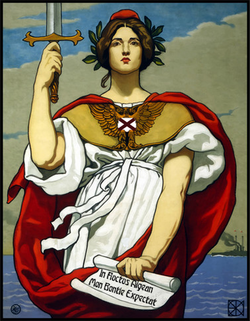 |
| Society |
| Arts and literature |
| Other |
|
Burgundie portal |
The 319,990 who live permanently on Wintergen are primarily Catholic Bergendii with growing population of other Occidentals from Faneria and Vithinja. There is a small community of Finna Urgic natives who still remain on the island as well, but they have long been integrated into the Burgoignesc way of life.
The language of Wintergen is the Burgoignesc language but due to its proximity, many people also speak some of the Coscivian language and Fhasen.
The cuisine Wintergen is made up of the historically available staples, mostly cod, Sea bass, small amounts of wheat and oats, and hearty fruits and root vegetables. A unique aspect of The cuisine is the eating of Ortolan.
Economy

Wintergen's primary sectors are as a customs and logistical hub between the Kiravian trade markets and Burgoignesc markets, fishing, logging, and apple cultivation. There are some minor oil reserves within the EEZ of Wintergen which are being tapped but the offshore drilling sector is comparatively small. Wintergen is a strategic military hub and the bases are a major economic engine driving $438 million/year of ancillary, non-military financial activity.
Employment
Because Wintergen's economy is a high-low mix of sectors from research to traditional fishing and herding, opportunities abound for Ouintergens at all skill and education levels, which has helped the islands maintain a fairly steady unemployment rate of around X% for the last decade. Burgundie's high emphasis on education translates to a particularly educated and skilled workforce, leading to lower unemployment compared to less educated countries in Kiro-Borealis. The islands' economic diversity cushions against overreliance on any single industry, which has demonstrably made the island more resilient during downturns. Since Burgundie strives for Total Economic Engagement and espouses equal rights and opportunities regardless of gender, race, ethnicity, ability, or background, Wintergen benefits from improved access to education and training, impacting employment prospects across various fields.
Agriculture


The apple varietals of Wintergen have been refined over the last 150 years to focus on apples that are desirable for cider and calvados, which, along with lumber, are Wintergen's primary export. About 20% of the apples harvested are sold as is to fruit sellers. 1-3% are retained for a growing agro-tourism market to be handpicked by tourists from orchards.
Other key agricultural products include strawberries, apples, raspberries, wild lowbush blueberries, half-high blueberries, lingonberries, cranberries.
Brewing, and distilling
Cider brewing
All apples harvested for alcoholic beverages are first crushed into cider and then fermented, the apples to be kept as hard cider are fermented then bottled. The cider to be turned into Calvados is dry fermented and then sent on to the calvadoseuers.
Calvados distilling

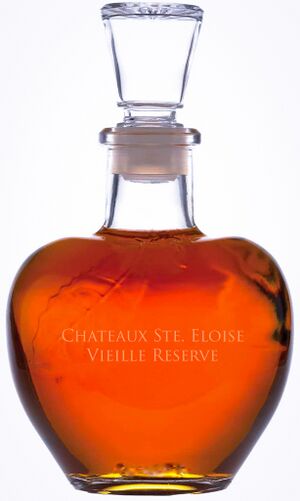
The apples are harvested and sold to one of three cider houses. There they are pressed into a juice that is fermented into a dry cider. It is then sold to one of two calvadoseuers where it is distilled into eau de vie. After two or three years of aging in oak casks, it can be sold as calvados. The longer it is aged, the smoother the drink becomes. The two largest calvadoseuers are:
- Chateaux Neuf Pins (Ænglisch: Chateaux Nine Pines)
- Chateaux Ste. Eloise (Ænglisch: Chateaux Saint Eloise)
Logging/Mineral extraction



Logging is the largest sector by land mass and employment on the island. 2/3rds of the island are covered in logging plantations that are operated by three companies: Irvine Timber Products, Roumeline Ltd., and Ouintergene Products. The primary species grown are softwoods, namely balsam fir and black spruce. The hardwood found in the region is mainly white birch.
Paper milling
Wintergen has a strong paper milling industry with 5 paper mills creating and exporting paper, cardboard, newsprint.
Fishing


Commercial fishing, particularly lobstering and trawling (cod, haddock, halibut, herring and mackerel). While lobster is the main seafood focus for Wintergen, the harvest of both oysters, seaweed, shrimp are on the rise. The main fishing fleets are based in Santmai since the shipping traffic makes fishing out of Hivernille less favorable. Contaminant and noise pollution has made fishing near Hivernille impossible and trying to navigate around the constant flow of ships more of a hassle than it is worth.
The two largest fleets are owned by the Havremaitre family and the Reauchfavle family, both operating out of Santmai.
Manufacturing
The manufacturing sector in Wintergen is very small with only two manufacturing plants outside of those in the timber business:
- O’Shea Container Shipping has a small shipyard and maritime repair facility; and
- LeClair Fishing and Trawling Hardware manufactures trawling and lobstering equipment.
Creative industries

In 2013, a young Vithenjan started a design studio in Santmai. The increased speed, power, and access to the internet meant that this type of white-collar work did not require a physical presence. He made a channel documenting his experiences on Thinkpages which became very popular on the Occidental Creative economy internet. Other young digital entrepreneurs and hipsters flocked to Santmai in the 2014-2021 timeframe changing the town entirely. What was once a logging and fishing outpost was, by 2020 a cosmopolitan village with universal, free gigabit wifi, some of the finest coffee shops in northern Levantia, 3 craft beer breweries, 4 barber shops specializing in beards and moustaches, and a general lumbersexual vibe. The average income jumped from $37,489 to $84,329 but the locals did not share in the new wealth. Santmai is now a globally renowned incubator for "artisanal, bespoke experiences in the fields of advertising and marketing, architecture, product design, graphic design, fashion design, and visual arts."
Sports and leisure
-
Hivernille Albatross Logo
-
Exterior of Hivernille Arena
-
Interior of Hivernille Arena
Wintergen has only one professional sports team, the Hivernille Albatrosses who compete in the Levantine Hockey League. They employ a total of 257 people directly. Founded in 1845 as the Merchants, the company team of the Burgoignesc North Levantine Trading Company, was formed by Emmanuel-Vichois Ermau de Milasse Esq. as a niche joke by the tropical Bergendii who were curious about the carietizein like sport played on the ice. They remained the Merchants until the advent of mascots in the 1940s when they adopted the albatross, the logo of the Burgoignesc North Levantine Trading Company, as their own. The fans connected with the albatross and put together a fanclub petition to have the name changed. In 1951, the team finally adopted its current name, the Albatrosses. They own the Hivernille Arena which is a multi-purpose sports arena complex and convention center on the outskirts of Hivernille. The arena has 8,149 seats in its ice hockey configuration and 10,000 for concerts and other events. The Hivernille Arena complex also hosts amateur and semi-professional hockey, basketball, Balle à la main, lacrosse, curling, Barette, banked track roller derby, Canne de combat, Savate, fencing, tennis, and pétanque events.
Albatross Fandom
Fans of the team are called Albatroaz and are notable for their violence and hooliganism. Female fans are also known for their promiscuous behavior and flamboyant style. The team is particularly popular with the working class of Hivernille, and to a certain extent is a symbol of resistance amongst the working class of other Burgoignesc cities. The logo is pervasive across the athletic wear of working-class Burgundie, regardless of which team the individual supports. It is not uncommon for poorer hockey fans to have a set of Albatross gear as well as their local team.
Trade
| Port Hivernille | |
|---|---|
 | |
| Location | |
| Country | |
| Details | |
| Opened | 1884 |
| Employees | 4,583 |
| Statistics | |
| Annual revenue | ₮ |
Port Hivernille was built in initially built in 1884 as part of the Burgoignesc attempts to legitimize their claim to the island in the aftermath of the First Fratricide as a fishing and whaling port. Since the end of the Kiro-Burgoignesc Wars and the First Great War at the dawn of the 20th century, Burgundie and Kiravia normalized relations and began to trade. The port expanded a number of times throughout the 20th century, most notably during the Second Great War when the port doubled in size to accommodate naval ships. Parts of the new port facilities were destroyed by a series of Fanerian naval and bomber raids. After the war, the port languished for a time until the advent of Containerization in the 1960s and 70s. The port was rebuilt from 1968-1973 to accommodate a container terminal. With the collapse of Kirosocialism in 1984, the port became an important hub of the new trade between capitalist Kiravia and Burgundie.
Infrastructure
Maritime
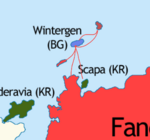
The Wintergen-Ultmar Ferry Service (owned and operated by Lansing Lines) operates out of Hivernille and has daily ro-ro passenger/vehicle ferry service to:
The Santmai Ferry Line is a fast ferry for people only from Santmai to Rimrinne det, Nordlan, three times a week.
Lighthouses
-
Iparnor Head Lighthouse
Rail
Wintergen uses Standard gauge, 1,435 mm (4 ft 8+1⁄2 in) for its freight rail. Borail (a portmanteau of boreal and rail) is the is the public-private joint-venture, intercity, passenger rail operator in Nauta Normand and Wintergen. It owns and operates all rail corridors, rights of way, and rolling stock that serve this purpose. Wintergen only has industrial, freight rail service. None of the 850km (528 mi) of rail is rated for passenger traffic. Because all of the rail is designed specifically around the logging industry the rail network all converges and estimates from Port Hivernille. The rail is all standard gauge but has a unique third rail and the distance of standard narrow gauge. This is because all timber train trucks are fitted with "guide wheels" or a small centrally located axle that works between the outermost rail to the center rail. These was added as a safety measure do you derailments during heavy rains that can wash out the ballast under some of the ties. The narrow gauge guide wheels have proven effective in reducing the number of derailments as a result of washed out ballast and rail shifting as a result.
Road
Car ownership is common in Wintergen but family untits typically only have one car. Transit options exist for school, work so cars are used primarily for chores and housekeeping and visiting friends and family. Because of the cost of gasoline, personal vehicles are rarely people's first choice for transit. Wintergen has 1647 km (1023 mi) of roads, but only 848km are improved. The remainder are logging roads that are owned, operated, and maintained by the logging companies. The majority of the roads are in Hivernille, Volcamor, and Santmai with large arterial roads connecting them. There are three bus systems the: Intercity Bus Link- a public intercity transit system that circulates between the major settlements. Sincere Charter Transit- a charter bus company that is used primarily to ferry workers from the towns to the barracks houses deep in the forests. These buses are rugged and designed for offroading. Wintergen Schools Regional Transit Authority- the school bus authority for the island. After school, on weekends and during holidays it also does rentals and charters. It is not uncommon for families to charter a school bus during a vacation to a remote camping ground or to visit family in another town if you want to bring a lot of luggage.
Air
XXX has one international airport, the NAME, in CITY NAME.
The Wintergen International Airport is a small, short haul airport facility that is shared by the civilian terminal and the Boreal Task Section of the Royal Air Service of Burgundie, Revenue Guard, and Navy of Burgundie Hyperthalatton.
There are 4 gates in the passenger terminal:
- Gate A: Operated by AiReal with a direct flight to Esquinia in the Burgoignesc Metropole once every three days
- Gate B: Operated by DeBonAire Airlines with service to Faneria, Vithinja, Scapa, and Caergwynn
- Gate C: Operated by DeBonAire Airlines with service to Suderavia, Hendalarsk, mainland Kiravian cities
- Gate D: Operated by DeBonAire Airlines with service to Collinebourg Yonderre, Brídhavn Fiannria
There is a small cargo terminal operated by AiReal Cargo.
| Name | Location | Type | Brief description | Code(s) | Picture |
|---|---|---|---|---|---|
| Wintergen International Airport | Passenger and cargo | 24/7/365 air traffic control operations, 2x runways, capable of receiving up to middle sized airframes, cargo terminal, passenger terminal, minimal maintenance facilities, integrated customs and border control service | ATRO: GWB |
Energy and electricity
The BORA Waste to Energy Compact went into effect in 2027 with construction of two Waste to Energy power planta starting in 2028. The two planta built in Wintergen generates approximately 208,000 kWh/day with a waste reduction capacity of 2200,000 kg/day.
Most of the electricity in Wintergen is provided by the Remalaund Power Factory outside of Volcamor. The Remalaud Power Factory is a Binary cycle, geothermal power station built in 2012 to replace the flash steam station geothermal plant that had been built in 1984, itself replacing a peat burning station that had previously powered the island.
There is also an undersea power and internet cable from Myshell, Faneria that supplies some energy as the grid fluctuates.
Phone service and internet
Phone service is provided by Island Mobile, a co-op with a basic infrastructure layout, that covers the three main municipalities on the island. The logging companies own truck mounted mobile repeaters to extend the service into their Unincorporated areas, but most companies also maintain a number of satellite phones in their timber camps. There are 6 cell towers that cover 84% of the population despite only covering 18% of the landmass of the island. Landline service is available and is still popular with those who live in the rural parts of Wintergen.
Highspeed internet service is provided by National Wireless Services a public-private ISP offered to areas of the Burgoignesc thalattocracy that don't have enough demand to create a competitive market. Residential internet speeds average 2 gigabits while commercial speeds are typically higher in the 3-4 gigabit range. National Wireless Services piggybacks on the Island Mobile towers and also has two towers of their own which provide highspeed wireless connections deep into the logging lands on the west of the island.
There is also a Global Maritime Distress and Safety System repeater and beacon on the island.
See also
- Pages using duplicate arguments in template calls
- Pages with non-numeric formatnum arguments
- Pages with broken file links
- Pages using infobox settlement with bad settlement type
- Pages using infobox settlement with unknown parameters
- Pages using infobox settlement with no coordinates
- Pages using country topics with unknown parameters
- Burgundie
- Sub-national Regions in Burgundie
- KRV
- Islands
- Burgoignesc islands
- Disputed Territory
- 2024 Award winning pages
















